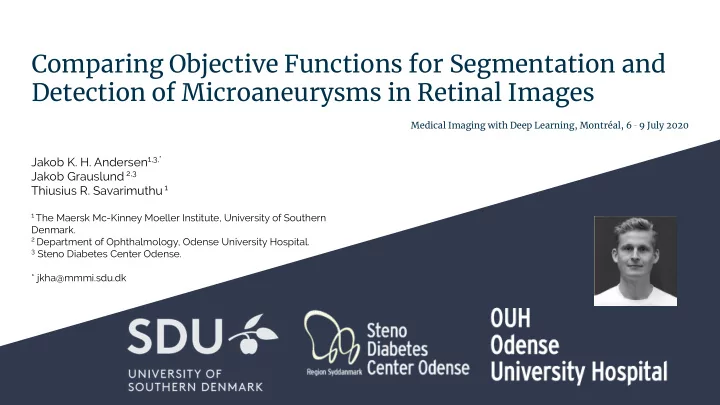

Comparing Objective Functions for Segmentation and Detection of Microaneurysms in Retinal Images Medical Imaging with Deep Learning, Montréal, 6 ‑ 9 July 2020 Jakob K. H. Andersen 1,3,* Jakob Grauslund 2,3 Thiusius R. Savarimuthu 1 1 The Maersk Mc-Kinney Moeller Institute, University of Southern Denmark. 2 Department of Ophthalmology, Odense University Hospital. 3 Steno Diabetes Center Odense. * jkha@mmmi.sdu.dk
Introduction Retinal microaneurysms (MAs) are the earliest sign of ❖ potentially sight threatening diabetic retinopathy (DR). MAs account for less than 0.5% of retinal images. ❖ (hard to detect). ➢ MAs indicate the lowest level of DR severity (level 1) ❖ ICDR scale 0 - 4 (Wilkinson et al., 2003). ➢ Deep neural networks have been successfully ❖ applied to binary classification of DR. [0, 1] v. [2, 3, 4] ➢ Less success for full scale classification (Nielsen et ❖ al., 2019). Possibly due to microscopic nature of MAs ➢
Introduction MA detection is labour intensive and resource demanding ❖ Costly ➢ Automatic MA detection could lead to: ❖ Decreased strain on medical professionals ➢ Reduced healthcare expenditure ➢ Automatic management of patient referral ➢ ■ Most diabetes patients elicit no signs of DR Faster diagnosis ➢ Fewer cases of DR related blindness ➢ ■ 90% can be eliminated by effective screening Improved full scale classification?
Introduction DNNs (e.g. U-nets) can learn to segment biomedical ❖ image features. Learning network parameters can be affected by ➢ class imbalance Different loss functions have been proposed as ❖ alternatives to standard crossentropy loss (1). Weighted crossentropy (2) ➢ Dice loss (Sudre et al., 2017) (3) ➢ Focal loss (Lin et al., 2017) (4) ➢ Focal tversky loss (Abraham and Khan, 2018) (5) ➢
Methods Compare DNNs trained for segmentation of retinal MAs. Evaluation ❖ ❖ DNNs trained using different objectives to MA detection ➢ ➢ determine the best loss function for ■ Free response ROC segmentation of MAs. ● Mean sensitivity at seven ■ Residual U-nets for all experiments average false positive per (Drozdzal et al., 2016, Zhang et al., 2018). image (FPAvg) thresholds of ■ Trained using publicly available retinal 0.125 , 0.25 , 0.5 , 1, 2, 4 and 8 images (E-ophtha: Decencire et al., 2013). ● Repeated measures ANOVA (n=233 ) with Post-hoc Tukey test Resulting network segmentation maps used for MA segmentation ➢ ➢ detection of individual MAs ■ Average precision (AP) ■ E-ophtha (n=80 ) Image level detection ➢ As well as for image level detection. ■ Bootstrapped AUC (95% CI) ➢ ■ Messidor (Decencire et al., 2013, Krause et DR classification ➢ al., 2017) (n=1287) ■ Cochrans’s Q and Post-hoc McNemar test
Results
Results
Results FROC score of 0.5448 (±0.0096) using weighted CE. ❖ Orlando et al., 2018: ➢ 0.3683 ■ Chudzik et al., 2018 ➢ 0.5620 (±0.2330) on 27 images ■ Savelli et al., 2020 ➢ 0.4795 ■ DL performs significantly worse (p < 0.001 ) ❖ Using the Focal Tversky objective we fail to detect any MAs ❖ AP of 0.4888 (±0.0196) using same objective ❖
Results AUC of 0.993 (95% CI: 0.980 - 1.0) using the Focal loss on ❖ E-ophtha images. No significant difference for image level detection on the 80 ❖ image E-ophtha test set. Excluding the Focal Tversky loss (AUC = 0.5) ➢ An AUC of 0.730 (95% CI: 0.683 - 0.745) (p < 0.001 ) using ❖ model with CE on Messidor images (adjucated ICDR scores) AUC of 0.9005 (0.882 - 0.918) (Original R0 vs. R1-R3) ❖ Orlando et al., 2018: ➢ ■ 0.8932 AUC 0.8932 (0.874 -0.912) (R0 & R1 v. R2 & R3) ❖ Orlando et al., 2018: ➢ 0.9374 ■
Conclusion We detect MAs with high sensitivities at low FPAvg: ❖ 0.5743 (±0.0054) at 1.08 FPAvg ➢ Losses based on the Crossentropy (weighted Crossentropy and Focal loss) perform at least as well or better ❖ than the DL and FTL despite these being designed to deal with unbalanced data. Results suggest that it is important to benchmark new objectives against losses based on the ➢ Crossentropy as we achieve the best performance in all our test using these. MA detection can be used to detect low levels of DR ❖ AUC of 0.730 (95% CI: 0.683 - 0.745) ➢ ICDR level 0 v. level 1 ■ AUC of 0.9005 (0.882 - 0.918) ➢ ■ R0 vs. R1-R3 AUC 0.8932 (0.874 -0.912) ➢ R0 & R1 v. R2 & R3 ■
Thank you!
Recommend
More recommend